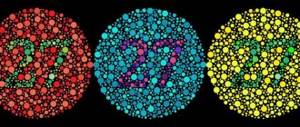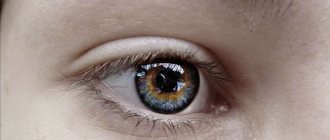Symptoms of the disorder
Colorblindness manifests itself differently in everyone, but it is worth paying attention to the signs that are typical for any case of the disease:
- Some or all colors are not differentiated.
- There are manifestations of nystagmus - oscillatory eye movements.
- Visual acuity is below normal.
There is a certain pattern according to which color blindness is inherited.
Inheritance of color blindness
Hereditary color blindness is directly related to the X chromosome. It contains genetically stored information and is passed from mother to son. Due to the fact that men have 2 X chromosomes, this mutation cannot be compensated for by anything. Therefore, statistics show that among males, problems with color differences occur 20 times more often (from 4 to 8% of registered cases of male color blindness and 0.4% of female ones).
A woman is only a carrier of a pathological chromosome, so in girls the disease manifests itself if both parents suffer from the disease. At the same time, she may have not only children who are unable to distinguish colors, but also grandchildren. If we talk about acquired color blindness, it occurs equally in both women and men.
Children's color blindness
Initially, color blindness in a child is very difficult to detect. When naming the colors of an object, he repeats after the adults and it seems that they differ in it. However, over time, you may notice that the child is not able to distinguish red or green from gray.
It is very difficult for children with color blindness to establish contact in society. They are considered inferior, although color blindness is not an indicator of mental ability. In order for a child to develop normal relationships in society, you need to talk with his teacher. He will find a way to convey to other children that color differences are not a reason to give up friendships. Parents are faced with the task of teaching their child to adapt to the environment. They must, for example, explain to him how to cross the road at a traffic light, without seeing which color is which. To soften the contrast between colors, you can also use glasses with wide temples, which will protect your eyes from bright light.
How colorblind people see
The main symptom is that the patient does not distinguish between tones and their shades. Instead of green, blue or red, a colorblind person sees gray. If this is a small child, then he does not always inform his parents about such visual defects, so the task of adults is to monitor the younger generation and their worldview, promptly respond to alarming symptoms and report them to the pediatric ophthalmologist. There are no such serious problems with the diagnosis of adult patients. The main symptoms of this disease are as follows, both single and complex:
- uncontrolled frequent oscillatory eye movements (nystagmus);
- difficulty distinguishing colors;
- low visual acuity as a temporary or permanent symptom.
Classification
Color blindness is classified according to the colors whose perception is impaired. The following types of this disease are distinguished:
- Achromasia is a complete lack of ability to distinguish colors. With this type of color blindness, a person is able to distinguish only shades of gray. Achromasia is caused by a complete lack of pigment in all types of cones, and is very rare.
- Monochromacy is the ability to perceive only one color. This type of disease is usually accompanied by nystagmus and photophobia.
- Dichromasia is the ability to distinguish between two colors. Divided into: protanopia - lack of perception of the color red;
- deuteranopia – inability to distinguish the color green;
- Tritanopia is a violation of the perception of the blue-violet part of the color spectrum, accompanied by the absence of twilight vision.
Trichromasia is the ability to perceive all three primary colors. There is normal and abnormal trichromasia.
Anomalous trichromasia is a cross between dichromasia and trichromasia. With this pathology, a person is unable to distinguish shades of primary colors. Similar to dichromasia, anomalous trichromasia includes protanomaly, deuteranomaly and tritanomaly - weakened perception of red, green and blue hues, respectively.
Professional suitability
People working in the transport sector are required to be tested for sensitivity to flowers. Practice has shown that a defect can lead to transport accidents and human casualties.
A visual defect prevented young people who wanted to become a pilot, train driver, sailor, or driver from realizing their dreams. In Russia, driver's licenses are not issued if you have color vision anomalies to drive a car. Abroad, colorblind people have the right to drive private vehicles.
Important! To teach children with color vision deviation to cross the road, to remember what the colors at a traffic light look like in their perception and the order of the luminous signs.
The genetic defect transmitted from parents does not affect visual acuity, does not interfere with achieving high results in life situations, and the disease rarely develops. The colorblind artist Vrubel, the French painter Charles Merion, the Hollywood film director Christopher Nolan and other celebrities achieved extraordinary success.
This disease was first described in 1794 by D. Dalton, who also had this visual impairment. Men get sick more often - 8%, less often - women - up to 0.5%.
The main cause of color blindness is a genetic defect in the X chromosome. Also, disturbances in color vision can occur after taking certain medications, injuries or diseases of the eyeball.
A person distinguishes colors thanks to the presence in the central part of the retina of the eye of special nerve cells, whose name is “cones”. These cells contain several types of pigment that are sensitive to the 3 primary colors - red, green and blue. If one type of nerve cell does not function, a person will not be able to distinguish this particular color. This condition is called dichromasia.
Dichromats - people who do not perceive 1 color - are divided into 2 groups:
- Red color blind – protanopia.
- People who are color blind to green are deuteranopia.
The third group of color vision disorders - tritanopia or violet color blindness - is extremely rare.
When damage occurs to all 3 types of nerve cells, monochromasia occurs - complete color blindness.
Only women are carriers of a genetic defect.
Prevention
Since color blindness is predominantly a hereditary disease, prevention is powerless. The only thing that two people with this diagnosis who are planning to start a family should understand is that they have a very high risk of having color-blind children. In such marriages, girls with this pathology also appear.
However, we should not forget that sometimes deviation is a consequence of external factors. So it is quite possible to talk about the prevention of this disease in such cases:
- timely diagnosis and quality treatment of cataracts;
- ensure that the child does not take powerful medications for a long time;
- avoid traumatic brain injuries.
Was your child diagnosed with color blindness at an ophthalmologist's appointment? The first thing parents need to do in this case is not to panic and take it for granted. The second step is to understand that this is a feature of his vision, and not a disease. This will help the family overcome all conventions and allow the baby to adapt normally to society and the environment.
Colorblindness
in children, this is a hereditary disease, in extremely rare cases it can be acquired in nature, the essence of which is the inability to distinguish one color or several at once.
The disease is hereditary, the gender ratio is 99:1, mostly men are affected, and women are latent carriers of the gene. The disease is almost always congenital, but its detection often takes many years.
As a result of color blindness, children do not receive the necessary information, which subsequently affects their development. But this is not the worst thing, because a child who suffers from a form of color blindness such as deuteranopia (red color blindness) can simply confuse the color of a traffic light and get hit by a car.
Color blindness in children is quite difficult to diagnose, due to the fact that the age at which children begin to meaningfully name colors is approximately 3-4 years. And in order to consolidate color determination skills, it is necessary to diagnose diseases before this age. This can only be done by observing the child.
in children at an early age it is possible based on such characteristics as: drawing grass, sky, water, sun with colors different from real colors.
For example, if your child draws the sky green and the grass red, this is a reason to be wary. The second sign by which a disease can be suspected: place 2 identical candies in front of the child, but one should be a black or gray repulsive color, and the second should be a bright, beautiful color. A healthy child almost always chooses the second one. And the patient, not feeling the difference, chooses at random.
Colorblindness in children is not a reason to be upset or overly concerned about it. If your child is diagnosed with dichromia - distinguishing between two primary colors out of three, he will still be able to subsequently obtain a driver's license, and will also not experience restrictions when choosing a job.
Currently, there is no effective treatment for color blindness in children. A certain compensatory reaction can be developed on the basis of logical conclusions and the thinking characteristics of memory, such as remembering the order of colors in a traffic light: red, yellow, green.
Experimental methods for treating color blindness in children are being developed, such as the introduction of missing genes into the retina using genetic engineering methods, but so far this method is undergoing laboratory testing.
ratings, average:
out of 5)
Breaking news!
Before you start reading the article, find out about the current pharmacy chaos.
Color blindness in childhood occurs as a hereditary or acquired disease. A child with such a pathology cannot distinguish one or more colors from other color shades. More often boys are affected by color blindness, while girls are simply carriers of the gene. A doctor who will conduct appropriate research can tell parents how to determine color blindness in a child. When making a diagnosis, it is necessary not to panic, but to try to teach the child to live harmoniously with this feature of his body.
Kinds
This disease in the field of ophthalmology is rare, but, in any case, requires detailed diagnosis using clinical methods. The predominant types of color blindness are determined according to several evaluation criteria. By type of inheritance:
- congenital (transmitted from sick parents during the prenatal period);
- acquired (the diagnosis appears throughout life under the influence of pathogenic factors).
When the perception of only one color is impaired (abnormal trichomacy), color blindness has the following conditional classification, which facilitates quick diagnosis:
- protanomaly, characterized by problems perceiving the color red;
- tritanomaly with impaired blue color perception;
- deuteranomaly with problems distinguishing the color green.
A disease in which the patient is unable to distinguish between two colors is officially called dichromatism. The diagnosis classification is as follows:
- deuteranopia, in which the problematic colors are green mixed with light pink;
- tritanopia, in which there are certain difficulties in perceiving the blue part of the spectrum, and a loss of violet tint occurs;
- protanopia, in which there is an absence of the red part of the spectrum, the mutation occurs in dark green or brown shades.
The presumptive diagnosis can be clarified only after a detailed diagnosis using clinical and laboratory methods. The main classification of color blindness according to the characteristics of color perception is presented in the following list:
- achromasia (achromatopsia), in which the patient has black and white vision;
- monochromasia, when a person distinguishes only one color (usually blue);
- dichromasia, in which two primary tones (yellow or orange and blue) are problematic for perception;
- abnormal trichromasia, in which patients see 3 primary colors, but one of them is distorted.
How does pathology manifest itself: symptoms and types
Symptoms of color blindness are individual in each individual case. But the general and main autosomal symptom of the disease is impaired color perception. It is not necessary that color blindness is accompanied by a decrease in visual acuity or becomes a determining factor for the development of other ophthalmological diseases. Rather, on the contrary, as mentioned earlier, primary eye diseases can lead to impaired color vision as a side effect.
Depending on the form of color blindness, patients perceive colors differently, and the impairment can range from minor to complete color blindness.
Mild achromatopsia is observed quite often; severe disorders and complete color blindness are, on the contrary, rare. The type of pigment that is missing—blue, green, or red—depends on which colors colorblind people cannot distinguish. Mostly the red spectrum is not perceived, less often blue-violet and green.
If the patient cannot perceive two colors, this form of color blindness is called “pair blindness.” If a person cannot distinguish colors at all, which is extremely rare, complete color blindness or achromasia is diagnosed. Depending on which color or which pairs of colors a patient of any age cannot distinguish, three degrees of color blindness are distinguished:
Congenital glaucoma in children + photo
- Protanotopy, or first degree - green and red shades are confused.
- Deuteranotopia, or second degree, is when the patient is unable to distinguish green from blue.
- Tritanotopia - a person cannot distinguish between blue and yellow shades, in addition, this group of patients does not have twilight vision.
Lack of twilight vision or night blindness is caused by a lack of light-sensitive or photosensitive pigment - rhodopsin.
This is interesting: there are cases when a patient, due to the inability to perceive shades of one color, enhances the perception of shades of another. For example, many colorblind people who cannot distinguish red perceive many more shades of green and khaki, which are inaccessible to the average person's eyes.
Famous colorblind people
There are many recognizable personalities in world culture who were naturally color blind . This did not prevent such brilliant people from achieving world fame and popularity, leaving a colossal imprint on history as an example for future generations. For example, John Dalton is well known, who had a congenital defect in color perception. He was the first to describe the symptoms of the disease to generations, and this happened in 1794. Other recognizable personalities are represented by the following list:
- The French painter Charles Meryon is famous for his graphic images, which are highly valued all over the world.
- The artist Vrubel did not use green and red shades in his masterpieces; the paintings were painted only in pearl-gray tones.
- Popular singer George Michael dreamed of becoming a pilot since childhood, but after diagnosis he turned out to be color blind and unsuitable for the army.
- The famous director Christopher Nolan also achieved world fame, while being congenital colorblind.
Causes
In the central part of the retina there are color-sensitive cone receptors - special nerve cells. Each of the three types of these cones has its own type of protein pigment that is sensitive to color. The first type of pigment is sensitive to red colors (maximum 570 nm), the second type of pigment is sensitive to green colors (maximum 544 nm), the third type of pigment is sensitive to blue colors (maximum 443 nm).
People who have normal color vision have all three pigments (red, green, blue) in sufficient quantities in their membranes. They are called trichromats.
As noted above, color blindness can be congenital or acquired. Let's consider both types.
The hereditary transmission of color blindness is associated with the X chromosome and is more often transmitted from a carrier mother to her son, which is why it occurs twenty times more often in men than in women. From 2 to 8 percent of men and less than half a percent of women suffer from varying degrees of color blindness.
At the same time, some types of color blindness are considered not a “hereditary disease”, but a certain feature of vision. Thus, according to the results of research by British scientists, those people who cannot distinguish between red and green colors distinguish many other shades (for example, shades of khaki, which seem the same to people with normal vision).
Acquired color blindness develops only in the eye where the optic nerve and retina are affected. With this type of color blindness, there is a progressive deterioration and some difficulty in distinguishing between yellow and blue colors.
Causes of acquired color vision disorders:
- age-related changes - cataracts (clouding of the lens). Both color perception and distance vision are reduced;
- taking various medications, which can lead to both temporary and permanent impairment of color perception;
- eye injury resulting in damage to the retina or optic nerve.
Inheritance mechanism
Color blindness in humans is a damaged mechanism for reproducing the color image of vision. In most cases, color blindness is inherited, from the maternal side to the son. The mother perceives colors normally, but passes on the damaged X chromosome gene through the male line.
Men are 20 times more likely than women to suffer from the disease. The reason is the presence in males of one X chromosome received from the mother. Girls who have two X chromosomes are rarely color blind.
The mother's unhealthy X chromosome is replaced in the daughter by another X chromosome. The damaged gene can be passed on from the father to the girl, who becomes its carrier and passes it on to her sons. Daughters suffer from color blindness if the father and mother suffer from color blindness.
The retina of the organ of vision has nerve cells that are located in. Cell pigments sense blue, red and green. People see the surrounding reality with various shades by mixing the three main colors.
The absence of one of them leads to a violation of tone perception. The hereditary disorder affects both organs of vision. There is a problematic vision of tones acquired as a result of injuries, cataracts, weakened vision, and other factors.
The vast majority of cases of color blindness are the result of inheritance. As already noted, in most cases, color blindness is inherited, and only in some cases can it be acquired during life.
A congenital eye disorder occurs due to the fact that pathological genes are passed on during the conception of a child, which in turn cause the disorder after birth. To diagnose color blindness, special polychromatic tables are used.
Cases in which women suffered from hereditary color blindness have not been recorded. Women are carriers of a gene with pathological hereditary information, but they themselves do not suffer from such visual impairment.
Therefore, if a boy is born, the pathological gene will develop in his body. When a female child is born, the likelihood of the disease being inherited is excluded. In view of this, we can conclude that the heredity of color blindness is directly influenced by the gender of the child and the presence of pathological genes in the parents.
In this matter, the problem of color blindness among children is very acute. This is due to the fact that, due to its physiological characteristics, a child does not perceive most colors until the age of three.
Only after crossing the age threshold of three years, color discrimination gradually begins. In turn, only then can it be determined whether the child is hereditary color blind.
It is also worth noting that in cases where color blindness is inherited, people with such a disorder cannot distinguish a certain color. However, their eyes are more sensitive to other colors and shades, resulting in a color spectrum that can exceed that of even a healthy person.
Another distinctive feature of hereditary color blindness is that the disease does not cause any changes in the condition of the eyes. With acquired visual impairment, various pathological changes often occur, such as decreased visual acuity, the appearance of cataracts, and others.
In general, color blindness is a common vision disorder that involves the eye's inability to distinguish certain shades and colors. This disorder can be either congenital or acquired and requires careful diagnosis and treatment.
Genetic tests
The disease often does not make itself felt throughout her life. But to a little person this pathology is transmitted at the genetic level. This happens even during pregnancy. Since women are carriers of the color blindness gene, preparation for the birth of a baby plays a very important role. Before planning a conception, the expectant mother is recommended to undergo a comprehensive examination. It will help identify the presence of the X chromosome in her body - the “culprit” of color blindness. The most effective examination method is a genetic test. Its uniqueness is that it allows you to clearly identify the mutated gene.
However, there is one “but”. Unfortunately, modern medicine is not well developed enough to eliminate a gene change if necessary. It turns out that the method, which is very expensive, does not have much practical significance. Its results only make it possible to “confirm” to future parents the risk of having a baby with color blindness. The child may not suffer from this pathology throughout his life. The test still does not provide a 100% guarantee of inheritance of the disease.
How is color blindness transmitted?
It is useful for people to know the ways of transmission of the disease, because the presence of the disease in a parent does not mean that the child will also have this problem. It all depends on the combination of damaged and healthy genes of the father and mother.
Inheritance scheme:
- A healthy girl and a colorblind man will give birth to a girl who will become a carrier of the pathological gene, but will not suffer from color blindness. The couple's son will be born completely healthy.
- In an ordinary man and a carrier mother, there is a 50% chance that the daughter will inherit the pathology, but does not suffer from it herself. Boys can be born both healthy and colorblind.
- A sick mother and a healthy father will give birth to a daughter who will become a carrier of the pathological gene. In this case, all boys will become color blind.
- In a man with color blindness and a carrier woman, the daughter may acquire color blindness or not get sick. The same can be said about boys.
- When parents are color blind, all their heirs will suffer from the pathology.
As you can understand, color blindness is inherited from both mother and father. Given this fact, it is recommended to check children for the presence of a pathological gene and, if necessary, take measures to improve the child’s quality of life.
How color blindness is inherited
As mentioned above, color blindness is inherited by all children, but not everyone has it. The likelihood of the disease depends on the combination of healthy and defective genes in the parents:
- the woman distinguishes colors, the man is colorblind: in such a couple, the daughters will accept the defective gene and become its carriers, while the sons will remain healthy;
- the woman is a carrier of color blindness, the man is healthy: in such parents, in half the cases, daughters will also become carriers of the gene, the probability of the disease in sons is 50%;
- the woman is a carrier, the man is colorblind: half of the daughters will become carriers, half will become colorblind, the probability of the disease for sons is 50%;
- the woman is sick, the man is healthy: girls will become carriers, all boys will have color vision impairment;
- both parents are colorblind: both sons and daughters will be sick.
Thus, it is clearly seen that the inheritance of color blindness is closely related to the gender of the child: the risk of the disease is much higher in boys. Girls are color blind only if both their father and mother suffer from color blindness. Color blindness is passed down within a family from generation to generation, so the risks of its occurrence in children can be calculated based on their pedigree.
Diagnosis of color blindness
To diagnose color blindness in ophthalmology, the Ishihara color test, the FALANT test, research using an anomaloscope and Rabkin’s polychromatic tables are used.
The Ishihara Color Test involves a series of photographs. Each of the drawings depicts spots of different colors, which together create a specific pattern, part of which falls out of the patients’ field of vision, so they cannot name what exactly is drawn. The test also includes images of figures - Arabic numerals, simple geometric symbols. The background of the figure in this test differs little from the main background, so patients with color blindness often see only the background, since it is difficult for them to differentiate minor changes in the color scheme. Children who do not distinguish numbers can be examined using special children's drawings (square, circle, car). The principle of diagnosing color blindness using Rabkin’s tables is similar.
Carrying out anomaloscopy and the FALANT test is justified only in special cases (for example, when hiring a person with special requirements for color vision). Using anomaloscopy, it is possible not only to diagnose all types of color vision disorders, but also to study the influence of brightness level, duration of observation, color adaptation, air pressure and composition, noise, age, training on color discrimination and the effects of drugs on the functioning of the receptor apparatus. The technique is used to establish norms for the perception and discrimination of color in order to assess professional suitability in certain areas, as well as control the treatment. The FALANT test is used in the United States to examine candidates for military service. To pass the test at a certain distance, you need to determine the color emitted by the beacon. The lighthouse's glow is formed by merging three colors, which are somewhat muted by a special filter. People with color blindness cannot name colors, but it has been proven that 30% of those with mild forms of the disease pass the test.
Congenital color blindness can be diagnosed at later stages of development, because patients often name colors that are not the same as they see them in connection with generally accepted concepts (grass is green, the sky is blue, etc.). If you have a family history, you should be examined by an ophthalmologist as soon as possible. Although the classical form of the disease is not prone to progression, with secondary color blindness caused by other diseases of the organ of vision (cataracts, age-related macular degeneration, diabetic neuropathy), there is a tendency to develop myopia and degenerative lesions of the retina, therefore immediate treatment of the underlying pathology is required. Color blindness does not affect other characteristics of vision, therefore, a decrease in acuity or a narrowing of the visual field in the genetically determined form is not associated with this disease.
Additional studies are indicated in the case of acquired forms of the disease. The main pathology, the symptom of which is color blindness, can lead to disruption of other vision parameters, as well as provoke the development of organic changes in the eyeball. Therefore, patients with the acquired form are recommended to undergo
In some cases, the symptoms of acquired color vision impairment can be eliminated after curing the underlying disease (neurosurgical treatment of brain damage, surgery to eliminate cataracts, etc.).
Forecast and prevention of color blindness
The prognosis for color blindness for life and ability to work is favorable, but this pathology worsens the patient’s quality of life. A diagnosis of color blindness limits the choice of profession in those areas where color perception plays an important role (military personnel, commercial vehicle drivers, doctors). In some countries (Turkey, Romania) issuing driver's licenses to people with color blindness is prohibited.
Specific preventive measures to prevent this pathology have not been developed. Nonspecific prevention involves consultation with a geneticist for families with consanguineous marriages when planning pregnancy. Patients with diabetes and advanced cataracts should be examined by an ophthalmologist twice a year. When teaching a child with a color vision defect in the lower grades, it is necessary to use special materials (tables, maps) with contrasting colors.
Color blindness or color blindness is a fairly rare disease diagnosed mainly in men. There is an opinion that women are not colorblind, but is this really true? Our article will provide comprehensive information on this issue.
Tests to detect color blindness in humans
Hereditary color blindness is extremely difficult to diagnose in childhood because there are no external clinical symptoms. Many people learn about their disease already in adulthood: by accident or during specialized diagnostics. Polychromatic tables are used to diagnose color blindness. A person is shown 27 tables, which depict colored circles or dots of different brightness: they all make up a certain pattern. If a person has this disease, he will only see a field filled with dots or circles; if a person is healthy, he will see a picture on the card.
The Ishihara test is also used. During this procedure, the patient is given a letter consisting of bright spots. A healthy person can easily read it, but a person with color blindness will find it difficult to complete this task.
These tests are suitable for adults who do not have mental disorders. Children and adults with mental disorders can distort the results, so special tests have been invented for them that determine the presence of the disease based on indirect symptoms.
In the absence of the disease, patients give over 90% correct answers, patients with color blindness - no more than 25%.
Types of disease
Colorblindness occurs in a tenth of the world's population. Absolute color blindness, in which almost no colors other than black, white and gray are visible, is not often diagnosed. Typically, a colorblind person is unable to see any one spectrum.
A person may not know for a long time that he has such a disease.
For the first time, John Dalton, an English physicist and chemist, drew attention to the problem of incorrect perception of colors. In 1794, he described in detail the color blindness from which he himself suffered, and first discovered it only at the age of 26
Dalton could not distinguish red from green. His illness was hereditary, as signs of it were observed in his sister and two brothers.
John Dalton spoke about his own perception of the world around him. The disease was subsequently named after him.
How can parents identify signs of color blindness in their child? It is recommended to observe him when he draws, works with plasticine or colored paper. He can depict objects that are not the same color as they really are. Of course, this may be due to the fact that the child simply does not know all the colors. However, children learn the information that the sky is blue, the grass is green, and the sun is yellow quite early.
Incorrect perception of colors can affect a student's academic performance. Pathology can create a lot of other problems. It is unknown how a child's color blindness will be assessed by his peers. In elementary school, many teachers work with visual materials. A student may find himself in an awkward situation by naming the wrong colors of an object to the whole class.
The problem with diagnosis is that we don’t know exactly how children under 3 years of age see the world. They will learn to truly distinguish colors by the age of 3-4 years. Much information related to shades is rote. How exactly the child perceives the object is unknown. However, if you notice blue grass, green sky and other “mistakes” in your baby’s drawings, show him to an ophthalmologist.
People with light-sensitive cones with protein pigments of three color perceptions are called trichromats, and those without one of them are called dichromats.
There are main types of deviation:
- protanopic dichromacy is characterized by the absence of red pigment;
- deuteranopic dichromacy indicates a lack of green photoreceptor;
- tritanopic dichromacy indicates a lack of blue receptors in cones.
The most common is blindness to red tones, less often the absence of blue photoreceptors.
With protanopia, nerve receptors do not respond not only to red color; for example, green leaves and trees are perceived in a yellow tone. People with deuteranopia do not perceive red and green hues. Tritanopia does not allow the perception of yellow and violet colors; the blue color is diluted with yellow and appears greenish.
Women recognize more shades than men. Scientists suggest that the reason lies in the genes responsible for the sensitivity of color recognition. In addition, the female retina contains more nerve cells, with the help of which a variety of halftones are captured.
What kind of disease is color blindness and why women also suffer from this visual impairment
For the first time, the condition in which a person cannot distinguish certain colors of the solar spectrum was described by the Englishman John Dalton.
He himself suffered from this, so he paid attention to this feature of visual perception. At that time, this discovery did not cause wide publicity and became one of the medical curiosities
Almost 100 years later, a major train accident in Sweden captured the public's attention. How colorblind people see colors will tell
At that time, this discovery did not cause wide publicity and became one of the medical curiosities
Almost 100 years later, a major train accident in Sweden captured the public's attention. How colorblind people see colors will tell
The cause of the death of many people was the color blindness of the diesel locomotive driver, who did not recognize the warning signal in time.
This attracted the attention of researchers to such an anomaly, and also tightened the requirements for vehicle drivers and workers operating complex mechanisms. Later studies revealed that chromosomal abnormalities are responsible for congenital color blindness.
Later studies revealed that chromosomal abnormalities are responsible for congenital color blindness.
Insensitivity to certain color shades is inherent in the structure of the X chromosome,
which means that it most often occurs among representatives of the stronger half of humanity.
At the same time, the statement that a woman cannot be colorblind is also not true.
Who gets sick more often: percentage of colorblind men and women
Percentage
male and female color blindness can be represented as follows.
About 10% of men suffer from color vision impairment to one degree or another For women,
this figure is much lower -
from 1 to 1.5%.
Such data is not entirely correct, because color blindness is divided into four types, depending on the immunity of a certain color spectrum.
In total, the visual apparatus can recognize three primary colors: blue, green and red. The combination of two or three of them gives a whole variety of color palette. If one of these pigments is missing in the retina of the eyes, or the nerve endings cannot recognize it, we are talking about the so-called dichromacy. Depending on which pigment is “out of zone”, the following conditions are distinguished.
Types of color blindness:
- .
The patient does not recognize the color red and its shades. A fairly rare phenomenon, occurring in 1 percent of men and 0.1% of women. - .
Lack of green pigment. It occurs more often than other conditions. It is diagnosed in approximately 7–8% of men and only in 0.3–0.4% of women. - .
Inability to perceive the blue range. Occurs in less than 1% of cases, and equally in men and women. In this case, we are talking about a defect of the seventh chromosome, which does not depend on the gender of the patients. - .
The rarest defect manifests itself in a complete lack of recognition of colors and their shades. The congenital form of achromatopsia occurs in less than 0.0001% of people.
The information provided allows us to conclude that female color blindness is a rather rare but common phenomenon. But, one way or another, in order to fully verify the presence of the disease, it is necessary to carry out.
On video: who suffers from color blindness - men or women
Inheritance of the color blindness gene
Color blindness is a disease that manifests itself as a lack of color perception of certain shades.
The disease is characterized by impaired retinal filtration of two or more colors.
It is necessary to consult a doctor in time to identify the cause of the condition. It can be hereditary or acquired. Such differentiation is important for prescribing treatment.
Is color blindness a hereditary disease?
There are two forms of the disease: hereditary and acquired from a primary disease. The first type includes a breakdown of a gene located on the X chromosome. This is the female sex chromosome.
If a woman has a pathological gene, most often she does not suffer from color blindness, but is a carrier.
The disease will be inherited by her son, who receives a Y chromosome from his father and a defective X chromosome from his mother.
Girls also suffer from color blindness, but only if both parents gave her defective chromosomes that impair color vision.
When a child receives a defective chromosome, the formation of nerve endings that are located on the retina of the eyes is disrupted. They are called cones. Their pigments are able to perceive all filters: green, red, blue.
When they act together, a nerve impulse is sent to the brain, which converts the signal and leads to the perception of many shades.
If the recognition of one of them is impaired, this can lead to serious disturbances in a person’s perception of the world around him.
The following disorders lead to secondary color blindness:
- cataracts, glaucoma, which interfere with the flow of light to the retina;
- a brain disease that damages the center of color perception (tumors, hematomas, neuralgia) or impairs the transmission of nerve impulses;
- mechanical damage to eye or brain tissue.
In this case, the disease is treatable, since the person does not have a pathological gene. When the primary disease is completely eliminated, the patient's vision is restored.
Risk group
There is a certain pattern of inheritance of the pathological gene for boys and girls. The risk group includes the following categories of patients:
- marriage of a colorblind woman with a healthy man – transmission of the pathological gene to male offspring;
- marriage of a colorblind man with a healthy woman - transmission of the pathological gene to female offspring, who become its carrier;
- the marriage of a man and a woman suffering from color blindness – the possibility of the disease appearing in both sexes of the offspring.
From the above classification it follows that the risk of developing the disease in a boy is much higher. In girls, it appears if both parents suffer from the disease. Therefore, when planning a pregnancy, it is recommended to take genetic tests, especially for those individuals who have the color blindness gene or their relatives suffer from the disease.
How to identify color blindness
Before reaching 4-5 years of age, it is difficult to identify the disease in a patient, since young children cannot always convey information. Hereditary color blindness cannot be cured, but it does not worsen vision over time.
Therefore, it does not matter at what age it is detected. For adults, it is necessary to determine which colors they cannot distinguish.
This is due to the fact that with color blindness, it is most often prohibited to drive a car or work in an enterprise that requires color differences.
In men
To diagnose the defective color blindness gene, you can donate venous blood. Using laboratory research methods, the state of the X chromosome is assessed. Only she can transfer the disease from patients to her offspring.
A man always suffers from color blindness if the X chromosome is damaged in the area of color perception.
Among women
Women have two X chromosomes in their genetic material. If one of them is damaged in the area of color perception, it is compensated by the other X chromosome. Therefore, a woman almost always perceives color normally, even if one of the chromosomes is damaged.
A woman may have color blindness if both parents suffer from the disease. In this case, the defective chromosome of the mother and father are connected, so the patient does not receive compensation from healthy genetic material.
This condition is confirmed laboratory by taking venous blood. Special laboratory diagnostic methods are carried out.










